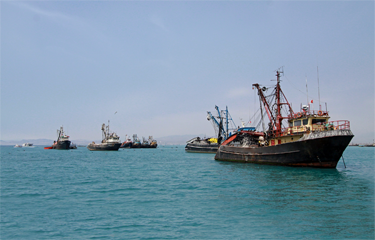Peru’s Ministry of Production (PRODUCE) has ordered a 13 August close to the year’s first anchovy season in the north-central region.
Peru divides its anchovy-fishing areas into two regions – south and north-central – with different capture limits and seasons set for each one. The north-central is Peru’s main fishing region, and for this season in April it established a quota of 2.51 million metric tons (MT). At the time observers said expectations were for a quota of 2.5 million to 2.8 million MT, which they said was evidence of sustainable fishery and a “very mature” fishmeal market with well managed anchovy biomass.
According to reports, 98.1 percent or 2.46 million MT of the north-central region’s quota was landed.
The Peruvian Sea Institute (Imarpe) – a specialized technical agency within PRODUCE which advises the state on marine conservation issues – will now carry out the monitoring and follow-up of the main biological, population and fishery indicators of anchovy resources, in order to report and recommend to PRODUCE the necessary fishing management measures.
Cayetana Aljovín, president of Peru’s National Fisheries Society (SNP), which represents the country's commercial fishing industry, said previously Peru’s anchovy capture limits for 2021 will be similar to those of 2020 if the biomass remains stable. If those numbers hold true, the season will likely contribute to a global production of 5 million MT of fishmeal and 1.2 million MT of fish oil production in 2021.
However, with the election of left-wing Free Peru party’s Pedro Castillo as president, fishing sector actors have admitted a sense of uncertainty for the sector’s future. Castillo, who was sworn in at the end of July for a five-year term that will last through 2026, had previously called for the nationalization of companies in industrial sectors deemed key to the national strategic interest. While he spoke specifically about mining but not the fishing industry, some in the industry have concerns about Castillo's interest in government involvement in the sector.
Exports from Peru surged during the first half of the year, according to the latest figures from the Ministry of Foreign Trade and Tourism. In January through June, Peruvian exports reached USD 24.4 billion (EUR 20.7 billion), 47 percent higher than the same period in 2020, with the fishing sector showing the strongest performance, surging 119 percent. Peru’s seafood sector is the second-largest exporter after mining, which registered USD 14.8 billion (EUR 12.6 billion) in exports in the first six months of the year, up 26.1 percent.
Peru exported 173 percent more fishmeal and fish oil in the first six months of 2021 than the equivalent time-period in 2020. Its exports of fishmeal rose 197 percent to USD 1.04 billion (EUR 88.4 million) and fish oil grew 110 percent to USD 280 million (EUR 238 million). The country’s exports of fresh and frozen fish, as well as prawns, grew 67.6 percent to USD 314 million (EUR 267 million). The large increases over last year are primarily due to the changing economic conditions related to the COVID-19 pandemic.
The positive performance in overall foreign trade was favored mainly by higher international prices and, to a lesser extent, by the recovery of Peruvian production and exportable supply, which was affected in 2020 by the health policies applied to mitigate COVID-19, according to the ministry report, which highlighted increased foreign commerce with China (up 73 percent), the European Union (up 30 percent) and the U.S. (up 21 percent).
Peruvian Minister of Foreign Trade and Tourism Roberto Sánchez said the government hopes the results can be translated into more opportunities and jobs for Peruvians.
“For this, it is important to intensify relations with our business partners. We will promote the opening of markets for bilateral trade and regional integration to contribute to the growth of exports, production, employment, and foreign exchange earnings,” he said, calling the fishing sector “the most dynamic” during the period.
Recently, the Commission for the Promotion of Peru for Export and Tourism (Promperú) announced the launch of the Peru Marketplace platform, whereby buyers from the U.S., Canada, Mexico, Panama, Ecuador and Chile will be able to access Peruvian exports, including fishing and aquaculture. The six target markets are significant commercial destinations, comprising 42 percent of Peruvian non-mining exports, with total sales of USD 6.35 billion (EUR 5.4 billion) in 2020.
Promperú is positioning the platform with digital marketing campaigns, direct promotion with its commercial offices abroad, agreements with international e-commerce platforms, and a number of commercial promotion events.
Photo courtesy of Sociedad Nacional de Pesqueria







